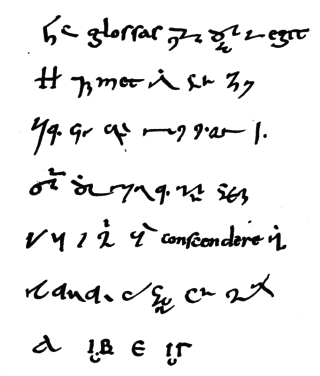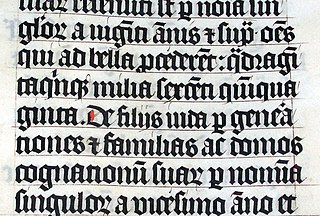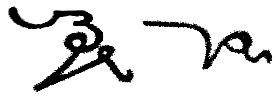Related Research Articles
An abbreviation is a shortened form of a word or phrase, by any method including shortening, contraction, initialism or crasis.

A manuscript was, traditionally, any document written by hand or typewritten, as opposed to mechanically printed or reproduced in some indirect or automated way. More recently, the term has come to be understood to further include any written, typed, or word-processed copy of an author's work, as distinguished from the rendition as a printed version of the same.
The symbol # is known variously in English-speaking regions as the number sign, hash, or pound sign. The symbol has historically been used for a wide range of purposes including the designation of an ordinal number and as a ligatured abbreviation for pounds avoirdupois – having been derived from the now-rare ℔.
The apostrophe is a punctuation mark, and sometimes a diacritical mark, in languages that use the Latin alphabet and some other alphabets. In English, the apostrophe is used for three basic purposes:
The slash is a slanting line punctuation mark /. It is also known as a stroke, a solidus, a forward slash and several other historical or technical names. Once used to mark periods and commas, the slash is now used to represent division and fractions, exclusive 'or' and inclusive 'or', and as a date separator.

Shorthand is an abbreviated symbolic writing method that increases speed and brevity of writing as compared to longhand, a more common method of writing a language. The process of writing in shorthand is called stenography, from the Greek stenos (narrow) and graphein. It has also been called brachygraphy, from Greek brachys (short), and tachygraphy, from Greek tachys, depending on whether compression or speed of writing is the goal.
Portable Game Notation (PGN) is a standard plain text format for recording chess games, which can be read by humans and is also supported by most chess software.

Copy editing is the process of revising written material ("copy") to improve quality and readability, as well as ensuring that a text is free of errors in grammar, style and accuracy. The Chicago Manual of Style states that manuscript editing encompasses "simple mechanical corrections through sentence-level interventions to substantial remedial work on literary style and clarity, disorganized passages, baggy prose, muddled tables and figures, and the like ". In the context of print publication, copy editing is done before typesetting and again before proofreading. Outside traditional book and journal publishing, the term "copy editing" is used more broadly, and is sometimes referred to as proofreading; the term sometimes encompasses additional tasks.

Tironian notes are a form of thousands of signs that were formerly used in a system of shorthand dating from the 1st century BCE and named after Tiro, a personal secretary to Marcus Tullius Cicero, who is often credited as their inventor. Tiro's system consisted of about 4,000 signs, extended to 5,000 signs by others. During the medieval period, Tiro's notation system was taught in European monasteries and expanded to a total of about 13,000 signs. The use of Tironian notes lasted into the 17th century. A few Tironian signs are still used today.

Scribal abbreviations, or sigla, are abbreviations used by ancient and medieval scribes writing in various languages, including Latin, Greek, Old English and Old Norse.
Op. cit. is an abbreviation of the Latin phrase opus citatum or opere citato, meaning "the work cited" or in the cited work, respectively.
The Latin adverb sic inserted after a quotation indicates that the quoted matter has been transcribed or translated as found in the source text, including erroneous, archaic, or unusual spelling, punctuation, and grammar. Sic also applies to any surprising assertion, faulty reasoning, or other matter that might be interpreted as an error of transcription.
Parenthetical referencing is a citation system in which in-text citations are made using parentheses. They are usually accompanied by a full, alphabetized list of citations in an end section, usually titled "references", "reference list", "works cited", or "end-text citations". Parenthetical referencing can be used in lieu of footnote citations.

The Phillips Code is a brevity code (shorthand) compiled and expanded in 1879 by Walter P. Phillips for the rapid transmission of telegraph messages, including press reports.

Telegram style, telegraph style, telegraphic style, or telegraphese is a clipped way of writing which abbreviates words and packs information into the smallest possible number of words or characters. It originated in the telegraph age when telecommunication consisted only of short messages transmitted by hand over the telegraph wire. The telegraph companies charged for their service by the number of words in a message, with a maximum of 15 characters per word for a plain-language telegram, and 10 per word for one written in code. The style developed to minimize costs but still convey the message clearly and unambiguously.
XPath is an expression language designed to support the query or transformation of XML documents. It was defined by the World Wide Web Consortium (W3C) in 1999, and can be used to compute values from the content of an XML document. Support for XPath exists in applications that support XML, such as web browsers, and many programming languages.
The full stop, period, or full point. is a punctuation mark used for several purposes, most often to mark the end of a declarative sentence.

English Braille, also known as Grade 2 Braille, is the braille alphabet used for English. It consists of around 250 letters (phonograms), numerals, punctuation, formatting marks, contractions, and abbreviations (logograms). Some English Braille letters, such as ⠡⟨ch⟩, correspond to more than one letter in print.

The Duployan shorthand, or Duployan stenography, was created by Father Émile Duployé in 1860 for writing French. Since then, it has been expanded and adapted for writing English, German, Spanish, Romanian, Latin, Danish, and Chinook Jargon. The Duployan stenography is classified as a geometric, alphabetic stenography and is written left-to-right in connected stenographic style. The Duployan shorthands, including Chinook writing, Pernin's Universal Phonography, Perrault's English Shorthand, the Sloan-Duployan Modern Shorthand, and Romanian stenography, were included as a single script in version 7.0 of the Unicode Standard / ISO 10646
References
- 1 2 "In Praise of TK: Why the Handy Shorthand Has a Surprising Emotional Hold on Me". Literary Hub. 2022-09-29. Retrieved 2023-06-10.
- ↑ "Hed, dek, lede, graf, tk: Live with it". Language Log. 2007-04-08. Retrieved 2010-02-08.
- ↑ Safire, William (1996-10-06). "Of Hacks and TK". The New York Times. ISSN 0362-4331 . Retrieved 2023-06-10.
- ↑ Chicago Style Q&A